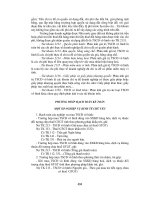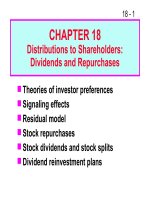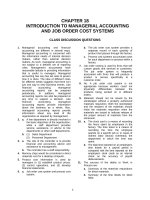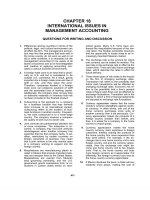Accounting26th ch 18
Bạn đang xem bản rút gọn của tài liệu. Xem và tải ngay bản đầy đủ của tài liệu tại đây (747.86 KB, 19 trang )
CHAPTER
18
Managerial Accounting
Concepts and Principles
Warren
Reeve
Duchac
©2016
human/iStock/360/Getty Images
Accounting
26e
Financial Accounting and Managerial Accounting
©2016
The Management Accountant
in the Organization
(slide 1 of 2)
•
•
•
In most companies, departments or similar
organizational units are assigned responsibilities for
specific functions or activities.
The operating structure of a company can be shown in
an organization chart.
The departments in a company can be viewed as
having either of the following:
o
o
Line responsibilities
Staff responsibilities
©2016
The Management Accountant
in the Organization
(slide 2 of 2)
•
•
•
A line department is directly involved in providing
goods or services to the customers of the company.
A staff department provides services, assistance, and
advice to the departments with line or other staff
responsibilities. A staff department has no direct
authority over a line department.
In most companies, the controller is the chief
management accountant.
o
The controller’s staff consists of a variety of other
accountants who are responsible for specialized accounting
functions.
©2016
Managerial Accounting in
the Management Process
•
The management process has the following five basic
phases, which interact with one another:
o
o
o
o
o
Planning
Directing
Controlling
Improving
Decision making
©2016
Direct and Indirect Costs
•
A cost is a payment of cash or the commitment to pay cash in
the future for the purpose of generating revenues.
o
In managerial accounting, costs are often classified according to the
decision-making needs of management.
For example, costs are often classified by their relationship to a segment of
operations, called a cost object.
• Costs identified with cost objects are either direct costs or
indirect costs.
o
o
Direct costs are identified with and can be traced to a cost object.
Indirect costs cannot be identified with or traced to a cost object.
©2016
Manufacturing Costs
•
•
•
The cost of a manufactured product includes the cost
of materials used in making the product.
In addition, the cost of a manufactured product
includes the cost of converting the materials into a
finished product.
Thus, the cost of a finished product includes:
o
o
o
Direct materials cost
Direct labor cost
Factory overhead cost
©2016
Direct Materials Cost
•
•
Manufactured products begin with raw materials that are
converted into finished products.
To be classified as a direct materials cost, the cost must be
both of the following:
o
o
An integral part of the finished product
A significant portion of the total cost of the product
©2016
Direct Labor Cost
•
•
•
Most manufacturing processes use employees to convert
materials into finished products.
The cost of employee wages that is an integral part of the
finished product is classified as direct labor cost.
A direct labor cost must meet both of the following criteria:
o
o
An integral part of the finished product
A significant portion of the total cost of the product
©2016
Factory Overhead Cost
•
•
•
Costs other than direct materials cost and direct labor that are
incurred in the manufacturing process are combined and
classified as factory overhead cost (sometimes called
manufacturing overhead or factory burden).
All factory overhead costs are indirect costs of the product.
Factory overhead cost also includes materials and
labor costs that do not enter directly into the finished
product.
o
Examples include the cost of oil used to lubricate machinery
and the wages of janitorial and supervisory employees.
©2016
Prime Costs and Conversion Costs
•
Direct materials, direct labor, and factory overhead
costs may be grouped together for analysis and
reporting.
o
Two such common groupings are as follows:
Prime costs, which consist of direct materials and direct labor costs
Conversion costs, which consist of direct labor and factory
overhead costs
– Conversion costs are the costs of converting the materials into a
finished product.
•
Direct labor is both a prime cost and a conversion
cost.
©2016
Product Costs and Period Costs
(slide 1 of 2)
•
For financial reporting purposes, costs are classified
as product costs or period costs.
o
o
Product costs consist of manufacturing costs: direct
materials, direct labor, and factory overhead.
Period costs consist of selling and administrative costs.
Selling expenses are incurred in marketing the product and
delivering the product to the customer.
Administrative expenses are incurred in managing the company and
are not directly related to the manufacturing or selling functions.
©2016
Product Costs and Period Costs
(slide 2 of 2)
•
•
As product costs are incurred, they are recorded and
reported on the balance sheet as inventory. When the
inventory is sold, the cost of the manufactured product
sold is reported as cost of goods sold on the income
statement.
Period costs are reported as expenses on the income
statement in the period in which they are incurred,
and, thus, they never appear on the balance sheet.
©2016
Balance Sheet for a Manufacturing Business
•
•
A merchandising business reports only Merchandise Inventory on
its balance sheet.
In contrast, a manufacturing business reports three types of
inventory on its balance sheet as follows:
o
o
o
Materials inventory (sometimes called raw materials inventory) consists
of the costs of the direct and indirect materials that have not yet
entered the manufacturing process.
Work in process inventory consists of the direct materials, direct labor,
and factory overhead costs for products that have entered the
manufacturing process, but are not yet completed (in process).
Finished goods inventory consists of completed (or finished) products
that have not been sold.
©2016
Income Statement for a
Manufacturing Business
(slide 1 of 3)
•
•
•
A merchandising business purchases merchandise
ready for resale to customers.
The total cost of the merchandise available for sale
during the period is determined as follows:
The cost of merchandise sold is:
©2016
Income Statement for a
Manufacturing Business
(slide 2 of 3)
•
•
•
•
A manufacturer makes the products it sells, using
direct materials, direct labor, and factory overhead.
The total cost of making products that are available
for sale during the period is called the cost of goods
manufactured.
The cost of finished goods available for sale is
determined as follows:
The cost of goods sold is determined as follows:
©2016
Income Statement for a
Manufacturing Business
(slide 3 of 3)
•
Cost of goods manufactured is required to determine
the cost of goods sold. The cost of goods
manufactured is often determined by preparing a
statement of cost of goods manufactured.
©2016
Flow of Manufacturing Costs
©2016
Uses of Managerial Accounting
•
Managerial accounting provides information and reports for
managers to use in operating the business.
o
o
o
o
o
Managerial accounting provides the cost of manufacturing a product,
which can be used to determine its selling price.
Managerial accounting allows for comparing the costs of manufacturing
products over time and can be used to monitor and control the cost of
direct materials, direct labor, and factory overhead.
Performance reports allow management to identify any large amounts
of scrap materials or employee downtime.
A report could analyze the potential efficiencies and dollar savings of
purchasing computerized equipment to speed up the production process.
A report could analyze how many units need to be sold to cover
operating costs and expenses. Such information could be used to set
monthly selling targets and bonuses for sales personnel.
©2016









